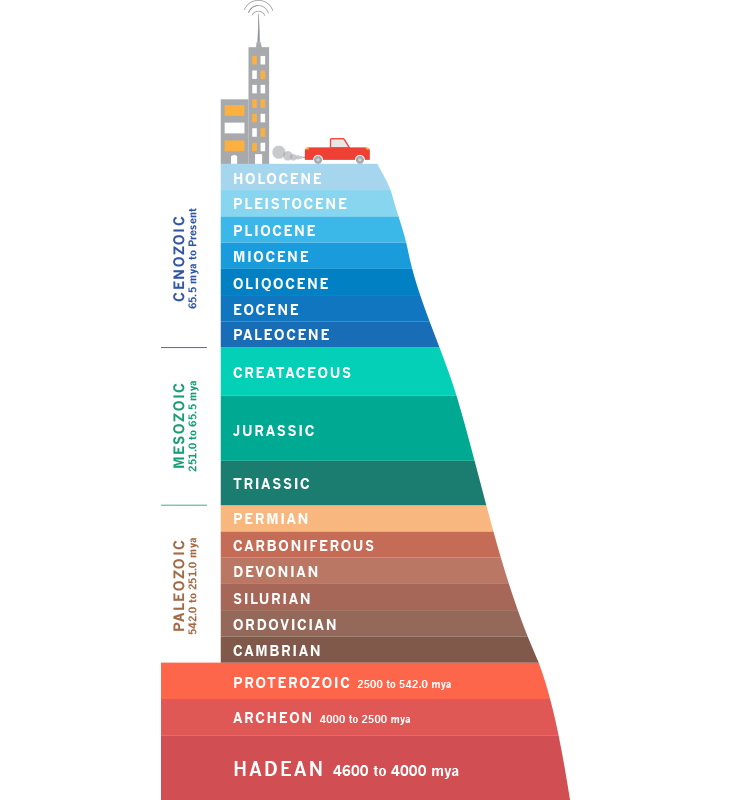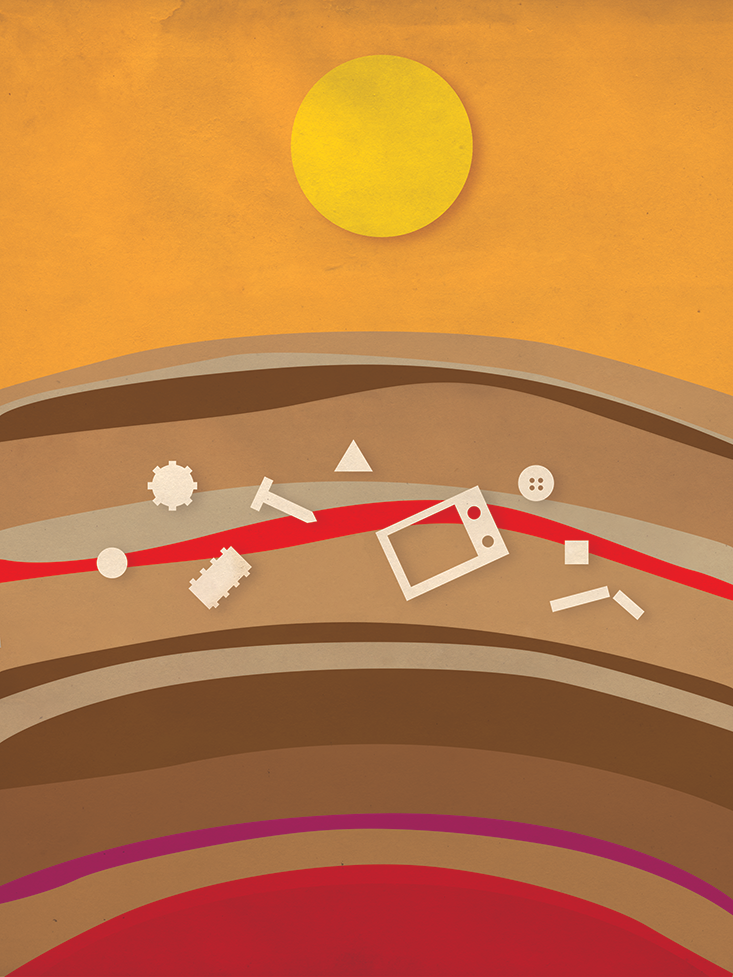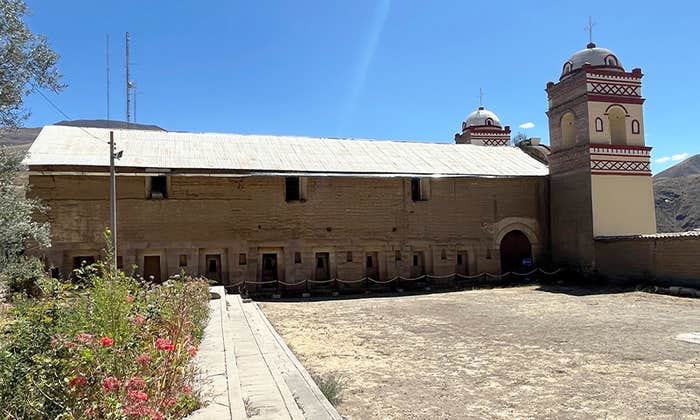A sheet of glass stretches along the entryway of the University of Leicester’s geology department. The glass protects a collection of fossils that are mounted to the wall in swirls, as if spiraling out of primordial time. Words have been sandblasted into the glass, snippets of a quote from James Hutton, the Scottish naturalist who in the late 18th century discerned the Earth’s age and founded the science of geology: “We find no vestige of a beginning, no prospect of an end… Time which measures everything is to nature endless.”
Walking to or from his nearby office, Jan Zalasiewicz occasionally casts a pensive gaze at the display. The display’s fossils will erode away eventually, though fragments of its shattered glass may endure for many millions of years. If in the far future the Earth still harbors geologists like Zalasiewicz, one of them could conceivably find a few translucent pebbles worn smooth by wind and rain, and surmise they were artifacts from a departed former world.
Zalasiewicz is a stratigrapher, a geologist who studies successive rock layers to codify the Earth’s deep history. He has built a reputation studying graptolites—tiny, extinct marine organisms previously so widespread that their fossils are used to date half-billion-year-old rocks from around the globe. More recently, however, Zalasiewicz has turned to an unorthodox project, a stratigraphy of the future. He leads a group of 30 experts that may, in the next year or two, decide whether mankind has so strongly affected planet Earth that we have entered into a new segment of geologic time characterized less by the mindless processes of nature than by human activity: the Anthropocene.
Around the turn of the millennium, Paul Crutzen, an atmospheric chemist who shared the Nobel prize for his work on ozone depletion, began popularizing the idea of the Anthropocene, citing evidence such as humanity’s alterations of biodiversity and our changing of the climate through the release of carbon dioxide and other greenhouse gases. Scientists agree that evidence of these and other global changes will leave a lasting impression in the geologic record. However, the Anthropocene is not recognized by the International Commission on Stratigraphy (ICS), the body which safeguards the geologic time scale. Zalasiewicz’s efforts may change that—his ICS working group gathers and debates evidence on the Anthropocene as a formal unit of time. His group’s task is to determine when exactly the Anthropocene started, and how its progression should be measured.
In 2016, the group plans to release a report at a meeting of the International Geological Congress. Then, the ICS could decide whether to bestow the Anthropocene with its blessing, rewriting geology textbooks to introduce a new phase of Earth’s history. The great difficulty in all of this is that no one yet knows how the Anthropocene will unfold. Our dominion over the planet may prove brief in the scope of deep time. Or, the Anthropocene could transform the entire planet into some new state that persists for the remainder of the Earth’s existence. Most wildly, the Anthropocene might surpass the boundaries of Earth itself, becoming interplanetary if our descendants extend our geological footprints to other worlds. Knowing that we have our own age to shape may alter what we do with it, with possible outcomes lying somewhere between our immortal reign and imminent demise.
In the 4.6 billion years of its existence, our planet has been writing its autobiography in layers of cooled lava and water-borne sediments. As new rock is laid down, it captures fossils and isotopes that geologists read like words on a printed page. Ancient rocks can also be inscribed with the marks of earthquakes, floods, geothermal heating, or shifting glaciers. Looking at this vast record, geologists watch for signals marking when the entire world changed. By discerning what the differences in rock layers mean, stratigraphers have slowly assembled the geologic time scale.
The biggest changes in the scale delineate Eons. The first Eon, the Hadean, lasted for 600 million years and featured an Earth covered in lava and steam. It ended around the time that our planet gained its great oceans. The Archean Eon lasted for the next 1.5 billion years, and was marked by the earliest evidence of life. Next came the Proterozoic Eon, a 2-billion-year stretch of time when Earth’s atmosphere gradually filled with oxygen and most life languished in single-celled forms. Finally, the Phanerozoic, the Eon in which we now live, took off with an explosion of multicellular life and animal diversity some 540 million years ago.
We have entered into a new segment of geologic time characterized less by the mindless processes of nature than by human activity.
Each Eon is divided into smaller sections of time called Eras, subdivided further into Periods. The Eras and Periods in our present Eon are chiefly distinguished by the rise and fall of groups of organisms in bursts of diversity and great mass extinctions, such as the flourishing of mammals that followed the end of the dinosaurs. Finer subdivisions of the geologic time scale, the Epochs, track subtle shifts in climate, geography, and biodiversity. Names of the Epochs are often sourced from Greek and rounded off with a “-cene” suffix, meaning “recent”: the Eocene, the Miocene, the Pleistocene. In Crutzen’s original formulation, the Anthropocene would be an Epoch, a “recent age of man.” But the Anthropocene could well become something larger.
“After another few centuries of business as usual in terms of our predation on other animals and our destruction of their habitats, we will arrive at another planetary-scale mass extinction,” Zalasiewicz says. “You’re looking at a very great deal of biological change, something that surpasses the Epoch and approaches a Period or even an Era in terms of its scale.”

Other geologists argue that the Anthropocene is not even an Epoch, and that it may not be suitable for the geological timescale at all. One critic, Philip Gibbard, a Cambridge stratigrapher and member of the ICS working group, says the time in which we now live should more properly be called the Late Holocene, because it’s consistent with this most recent official Epoch. “For the Anthropocene to merit formal definition, a global signature distinct from that of the Holocene is required that is marked by novel biotic, sedimentary, and geochemical change,” Gibbard wrote in a paper published last year.
Yet, Zalasiewicz counters that stratigraphers must contemplate formalizing the Anthropocene, as the term already regularly appears in scientific literature. “Other scientists are voting with their feet,” he says. “We’re just following to see if they are going in a sensible direction.”
Arguments are the norm among stratigraphers. To formalize most slices of time, they must reach a consensus about a single, precision-dated measure of rock that encapsulates an associated worldwide geological transition. Anointing this rock, called a “Global Stratigraphic Section and Point,” or informally, a golden spike, can take decades.
Consider the boundary between the Permian and Triassic Periods, which was laid down in rock some 250 million years ago. Rocks from the end of the Permian record the sudden, drastic disappearance of many different lineages of species. In the 1840s, geologists decided this mass extinction event was significant enough to warrant a new Period, the Triassic. But to define the beginning of the Triassic, they needed to link the Period’s beginning to the appearance of something new. It took the field more than 100 years to choose a fossil group to trace this global geological transition. Geologists settled upon a species from an extinct class of eel-like organisms called conodonts, creatures that emerged around the globe in the aftermath of the Permian extinction. Finally, in 2001, geologists reached agreement that the earliest appearance of this particular conodont species could be found in a layer of limestone in a quarry in southern China, making that layer the golden spike for the Triassic’s beginning.
“We’re always trying to look at this from the perspective of a geologist in a million years. There are good chances that many of our cities will have just eroded away in that period of time.”
Finding a golden spike to formalize the Anthropocene will unquestionably be more difficult. Unlike the 250-million-year-old sedimentary rocks capturing the Permian-Triassic transition, most of the Anthropocene’s possible rocks have yet to form, and those that may already contain signals of human activity are so recent that they confound many of stratigraphy’s geologic dating techniques. Those techniques often come with uncertainties far bigger than the 12,000 years that separate our modern world from the beginning of the Holocene. The golden spike marking the Triassic’s beginning, for instance, is accompanied by a dating uncertainty of about 400,000 years.
Consequently, any golden spike for the Anthropocene will need to record a signal that comes with finer resolution, perhaps year-by-year geochemical changes rather than the first appearance of some fossilized form. Much of the working group’s activities revolve around weighing which of humanity’s possible tracers makes the most precise signal, and where on Earth that signal will be best preserved. If one can’t be found, the only other option would be to overturn old stratigraphic traditions and assign the beginning of the Anthropocene to some abstract calendrical date rather than an actual sequence of rock.
 Because of the need for a lasting signal, skyscrapers, highways, and other city infrastructure probably won’t make the cut, says Colin Waters, a stratigrapher with the British Geological Survey and current secretary of the ICS working group. “We’re always trying to look at this from the perspective of a geologist in a million years,” he says. “There are good chances that many of our cities will have just eroded away in that period of time.”
Because of the need for a lasting signal, skyscrapers, highways, and other city infrastructure probably won’t make the cut, says Colin Waters, a stratigrapher with the British Geological Survey and current secretary of the ICS working group. “We’re always trying to look at this from the perspective of a geologist in a million years,” he says. “There are good chances that many of our cities will have just eroded away in that period of time.”
However, the situation changes for infrastructure already buried underground, such as subway networks, or things soon to be submerged, such as coastal cities built on massive, subsiding river deltas. As the deltas slowly sink into the sea, any structures built upon them become buried beneath thick layers of preservative sediment that eventually turns to rock. The sunken edges of seaside cities such as New Orleans, Shanghai, Lagos, and Amsterdam are already entering into the stratigraphic record. Still, such places aren’t the norm throughout the world, and consequently, Waters and many other geologists suspect they will form a weak global signal at best.

It may be that the Anthropocene will be marked more by all that becomes absent from a gone-away world than by the birth of anything new. As our fossil-fuel use increases the atmosphere’s load of carbon dioxide, more of that gas seeps into the seas, making them so acidic that carbonate-rich limestone and coral reefs dissolve and disappear. In the fossil record, future geologists may see a transition between white carbonate sediments and fossilized coral reefs and the dark, muddy strata of the Anthropocene.
The working group may be most swayed by a global signal known to stand the test of time: Radioactive fallout from nuclear testing and reactor accidents. Warhead detonations and core meltdowns can eject a cocktail of radioactive isotopes into the environment, to be carried by winds and currents around the globe. All those radioactive isotopes decay at specific rates, so their remains constitute manmade signals that offer extremely precise dates. “The radioactive fallout is really like a fingerprint,” Waters says.
Radioactive signals would begin to appear in the mid-20th century, a date that fits well with other key markers of the Anthropocene. John McNeill, a historian at Georgetown University, agrees that the mid-20th century would be an Anthropocene starting point that most people could agree on. He says coincident markers would include the upturn in greenhouse gas emissions, the large-scale production of fertilizer, massive deforestation, and the rapid extinction of species. “Sometimes,” he says, we “call this the ‘Great Acceleration.’ ”
But according to Crutzen’s original formulation, the Anthropocene starts with the development of the steam engine and the ensuing Industrial Revolution, placing its onset in the latter half of the 18th century. Others argue for even earlier origins. One proposal dates back some 12,000 years, to the sudden disappearance of many large mammals in Australasia, Eurasia, and the Americas at approximately the same time our ancestors colonized those regions. Rapacious hunting, some researchers believe, contributed to these mass extinctions, which we can already detect in the geological record. Other hypotheses trace the Anthropocene’s beginning to changes in air and soil that occurred between 2,000 and 8,000 years ago as agriculture spread across the planet. The earliest conceivable Anthropocene kickoff could even predate the emergence of modern humans, reaching back to the tools and fires of our hominid ancestors.
Some researchers take a more philosophical view of the Anthropocene. To them, dates and golden spikes are less important than the explicit recognition that we have the power to adjust the course of our planet for the better. Against centuries of Copernican and Darwinian demotions, the concept of the Anthropocene could remind people that they have the ability to shape the future of life on Earth. The Anthropocene, consequently, is as much a matter of morality and what it means to be human, as it is of geology and science. Rick Potts, a paleoanthropologist at the Smithsonian Institution, sees an official name for our period as catalyst for change. “The foundational question of the Anthropocene,” he says, “will be whether we can express our humanity by sustainably altering the Earth with compassion for the other creatures we share it with.”
Freelance writer Lee Billings is the author of Five Billion Years of Solitude: The Search for Life Among the Stars.






























